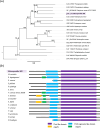Bioinformatics analysis of the Microsporidia sp. MB genome: a malaria transmission-blocking symbiont of the Anopheles arabiensis mosquito
- PMID: 39578727
- PMCID: PMC11585130
- DOI: 10.1186/s12864-024-11046-y
Bioinformatics analysis of the Microsporidia sp. MB genome: a malaria transmission-blocking symbiont of the Anopheles arabiensis mosquito
Abstract
Background: The use of microsporidia as a disease-transmission-blocking tool has garnered significant attention. Microsporidia sp. MB, known for its ability to block malaria development in mosquitoes, is an optimal candidate for supplementing malaria vector control methods. This symbiont, found in Anopheles mosquitoes, can be transmitted both vertically and horizontally with minimal effects on its mosquito host. Its genome, recently sequenced from An. arabiensis, comprises a compact 5.9 Mbp.
Results: Here, we analyze the Microsporidia sp. MB genome, highlighting its major genomic features, gene content, and protein function. The genome contains 2247 genes, predominantly encoding enzymes. Unlike other members of the Enterocytozoonida group, Microsporidia sp. MB has retained most of the genes in the glycolytic pathway. Genes involved in RNA interference (RNAi) were also identified, suggesting a mechanism for host immune suppression. Importantly, meiosis-related genes (MRG) were detected, indicating potential for sexual reproduction in this organism. Comparative analyses revealed similarities with its closest relative, Vittaforma corneae, despite key differences in host interactions.
Conclusion: This study provides an in-depth analysis of the newly sequenced Microsporidia sp. MB genome, uncovering its unique adaptations for intracellular parasitism, including retention of essential metabolic pathways and RNAi machinery. The identification of MRGs suggests the possibility of sexual reproduction, offering insights into the symbiont's evolutionary strategies. Establishing a reference genome for Microsporidia sp. MB sets the foundation for future studies on its role in malaria transmission dynamics and host-parasite interactions.
Keywords: Anopheles; Annotation; Biocontrol; Genome; Glycolytic pathway; Malaria; Microsporidia; RNA interference; Symbiosis; Transmission-blocking.
© 2024. The Author(s).
Conflict of interest statement
Declarations. Ethics approval and consent to participate: Not applicable. Consent for publication: Not applicable. Competing interests: The authors declare no competing interests.
Figures














Similar articles
-
The Plasmodium transmission-blocking symbiont, Microsporidia MB, is vertically transmitted through Anopheles arabiensis germline stem cells.PLoS Pathog. 2024 Nov 11;20(11):e1012340. doi: 10.1371/journal.ppat.1012340. eCollection 2024 Nov. PLoS Pathog. 2024. PMID: 39527638 Free PMC article.
-
Horizontal Transmission of the Symbiont Microsporidia MB in Anopheles arabiensis.Front Microbiol. 2021 Jul 28;12:647183. doi: 10.3389/fmicb.2021.647183. eCollection 2021. Front Microbiol. 2021. PMID: 34394019 Free PMC article.
-
A microsporidian impairs Plasmodium falciparum transmission in Anopheles arabiensis mosquitoes.Nat Commun. 2020 May 4;11(1):2187. doi: 10.1038/s41467-020-16121-y. Nat Commun. 2020. PMID: 32366903 Free PMC article.
-
A review on RNA interference studies in Anophelines to reveal candidate genes for malaria transmission blocking vaccine.Life Sci. 2024 Aug 15;351:122822. doi: 10.1016/j.lfs.2024.122822. Epub 2024 Jun 10. Life Sci. 2024. PMID: 38866221 Review.
-
Opening the toolkit for genetic analysis and control of Anopheles mosquito vectors.Curr Opin Insect Sci. 2018 Dec;30:8-18. doi: 10.1016/j.cois.2018.07.014. Epub 2018 Jul 26. Curr Opin Insect Sci. 2018. PMID: 30553490 Review.
References
-
- World Health Organization. World malaria report 2022. 2023.
-
- Ochomo EO, Milanoi S, Abong’o B, Onyango B, Muchoki M, Omoke D, et al. Molecular surveillance leads to the first detection of Anopheles stephensi in Kenya. Res Sq. 2023;v2:1–16. 10.21203/rs.3.rs-2498485/v2.
MeSH terms
LinkOut - more resources
Full Text Sources
Miscellaneous

